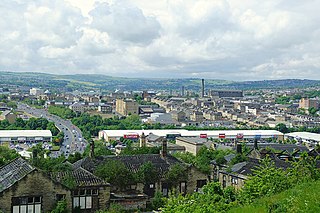
Manningham is an historically industrial workers area as well as a council ward of Bradford, West Yorkshire, England. The population of the 2011 Census for the Manningham Ward was 19,983.

Lister Mills was the largest silk factory in the world. It is located in the Manningham district of Bradford, West Yorkshire, England and was built by Samuel Cunliffe Lister to replace the original Manningham Mills which had been destroyed by fire in 1871. The mill is a Grade II* listed building, built in the Italianate style of Victorian architecture.

Undercliffe Cemetery is located between Otley Road and Undercliffe Lane in the Bolton and Undercliffe ward, Bradford, West Yorkshire, England. The cemetery stands atop a hillside overlooking the city and contains some very impressive Victorian funerary monuments in a variety of styles. It is a notable example of a Victorian cemetery where a number of rich and prominent local residents have been buried, notably mill owners and former mayors. Undercliffe Cemetery is grade II* listed by English Heritage in their Register of Parks and Gardens of Special Historic Interest in England.

Little Germany is an area of particular historical and architectural interest in central Bradford, West Yorkshire, England. The architecture is predominantly neoclassical in style with an Italian influence. Many individual buildings are listed, and Little Germany is also protected as a Conservation Area.

Bradford is a city in West Yorkshire, England. It is governed by a metropolitan borough named after the city, the wider county has devolved powers. It had a population of 349,561 at the 2011 census; the second-largest subdivision of the West Yorkshire Built-up Area after Leeds, which is approximately 9 miles (14 km) to the east. The borough had a population of 546,976, making it the 9th most populous district in England.

Henry Francis Lockwood was an influential English architect active in the North of England.

Barkerend is an inner-city area of Bradford, West Yorkshire, England, east of the city centre and surrounded by Undercliffe Cemetery, Bradford Moor, Laisterdyke, Bowling, Broomfields, Little Germany and Wapping, including an area of modern housing known as Pollard Park.

The Weavers' Triangle is an area of Burnley in Lancashire, England consisting mostly of 19th-century industrial buildings at the western side of town centre clustered around the Leeds and Liverpool Canal. The area has significant historic interest as the cotton mills and associated buildings encapsulate the social and economic development of the town and its weaving industry. From the 1980s, the area has been the focus of major redevelopment efforts.

Queen Street Mill is a former weaving mill in Harle Syke, a suburb to the north-east of Burnley, Lancashire, that is a Grade I listed building. It now operates as a museum and cafe. Currently open for public tours between April and November. Over winter the café is opened on Wednesdays. It is also viewable with private bookings.

Roberts Park is a 14 acres (5.7 ha) public urban park in Saltaire, West Yorkshire, England. Higher Coach Road, Baildon, is to the north and the park is bounded to the south by the River Aire. A pedestrian footbridge crosses the Aire and links the park to the village of Saltaire. The park is an integral part of the Saltaire World Heritage site.
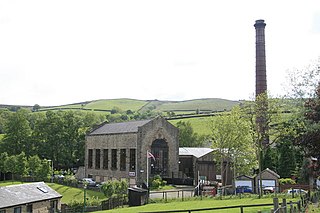
Bancroft Shed was a weaving shed in Barnoldswick, Lancashire, England, situated on the road to Skipton. Construction was started in 1914 and the shed was commissioned in 1920 for James Nutter & Sons Limited. The mill closed on 22 December 1978 and was demolished. The engine house, chimneys and boilers have been preserved and maintained as a working steam museum. The mill was the last steam-driven weaving shed to be constructed and the last to close.
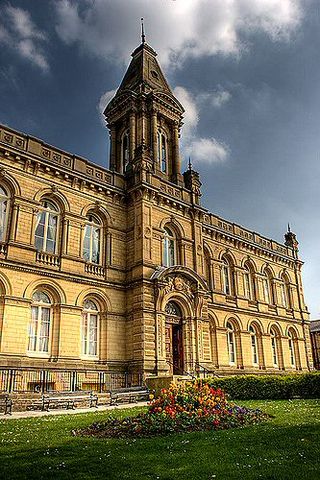
Victoria Hall, Saltaire is a Grade II* listed building in the village of Saltaire, near Bradford, West Yorkshire, England, built by architects Lockwood and Mawson.

Harden Beck is a stream that flows from Hewenden Reservoir, over Goit Stock Waterfall to the River Aire in Bingley, West Yorkshire. The route starts out further up the valley as Denholme Beck, Hewenden Beck and Hallas Beck. Its waters are fed by Thornton Moor Reservoir, Stubden Reservoir, Doe Park Reservoir and Hewenden Reservoir.
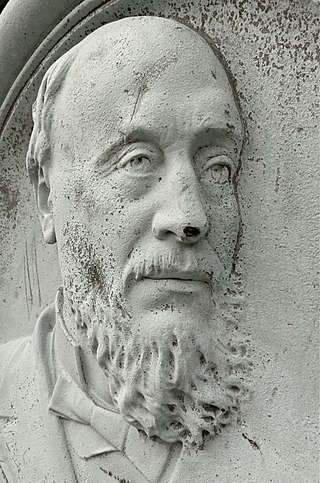
William Mawson was an English architect best known for his work in and around Bradford.

Bradford Dale, is a side valley of Airedale that feeds water from Bradford Beck across the City of Bradford into the River Aire at Shipley in West Yorkshire, England. Whilst it is in Yorkshire and a dale, it is not part of the Yorkshire Dales and has more in common with Lower Nidderdale and Lower Airedale for its industrialisation.

William James Morley FRIBA was an English architect who practised from offices in Bolton, Greater Manchester and Bradford, West Yorkshire.

Louis Ambler FSA FRIBA was an English architect.
Manningham is a ward in the metropolitan borough of the City of Bradford, West Yorkshire, England. It contains 76 listed buildings that are recorded in the National Heritage List for England. Of these, one is listed at Grade II*, the middle of the three grades, and the others are at Grade II, the lowest grade. The ward is to the northwest of the centre of Bradford, and is mainly residential, with some industry at the southern extremity of the ward. The listed industrial buildings are, or have been, part of the textile industry of the city. The listed residential buildings range from converted farmhouses and farm buildings, to terraces of houses and cottages, and to large villas. To the north of the ward are Bradford Grammar School, and part of Lister Park, and both contain listed buildings. The other listed buildings include churches, mosques and a synagogue, public houses, some or which have been converted for other uses, a group of almshouses and associated structures, a former police station, a hospital, schools, swimming baths, and a war memorial.
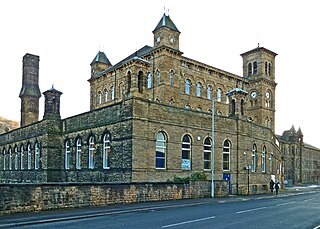
Dalton Mills is a 19th century Grade II* Victorian former textile mill located in Keighley, West Yorkshire, England. It was roughly 45,681 sq ft (4,243.9 m2) in size. Previously used as a set for Peaky Blinders, it was once claimed to be the largest textile mill in Yorkshire, massing over 2,000 employees. The internal parts of the building were destroyed by a large fire that broke out on 3 March 2022.






















